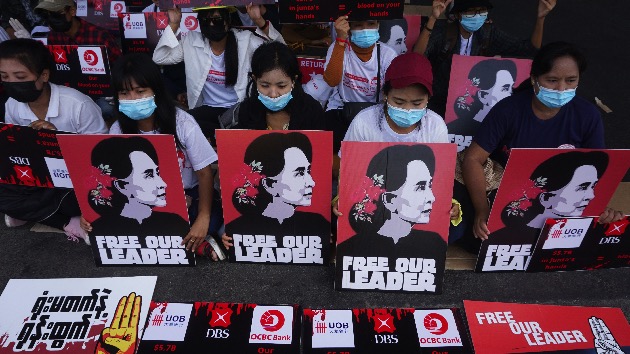
SAI AUNG MAIN/AFP via Getty ImagesBy KARSON YIU and MORGAN WINSOR, ABC News
(HONG KONG and LONDON) — Myanmar’s ousted leader Aung San Suu Kyi was seen Monday for the first time since she was detained in a military coup one month ago, appearing in a Naypyitaw court via videoconference.
The Nobel laureate, who leads the National League for Democracy (NLD) party, was initially charged with illegally importing six walkie-talkie radios. She was later charged with violating a natural disaster law by breaching COVID-19 protocols while campaigning during last year’s elections.
Suu Kyi, 75, appeared in court after a weekend of the deadliest violence that the Southeast Asian country has seen since the army seized power on Feb. 1. Police and security forces confronted peaceful demonstrations in several locations across Myanmar on Sunday and fired live rounds into the crowds, killing at least 18 people and wounding over 30 others, according to the Office of the United Nations High Commissioner for Human Rights, which cited “credible information” that it had received. Tear gas and stun grenades were also reportedly used in various locations.
More than 1,000 people, some of whom remain unaccounted for, have been arbitrarily arrested and detained in Myanmar over the past month, mostly without any form of due process. On Sunday alone, at least 85 medical professionals and students as well as seven journalists who were present at the demonstrations were detained, according to the U.N. Human Rights Office.
“We strongly condemn the escalating violence against protests in Myanmar and call on the military to immediately halt the use of force against peaceful protestors,” Ravina Shamdasani, spokesperson for the U.N. Human Rights Office, said in a statement Sunday. “The people of Myanmar have the right to assemble peacefully and demand the restoration of democracy. These fundamental rights must be respected by the military and police, not met with violent and bloody repression. Use of lethal force against non-violent demonstrators is never justifiable under international human rights norms.”
U.S. Secretary of State Antony Blinken took to Twitter on Sunday night to condemn the “abhorrent violence against the people of Burma,” using Myanmar’s former name under British colonial rule. Blinken said the U.S. government “will continue to promote accountability for those responsible” and “stand[s] firmly with the courageous people of Burma.”
Suu Kyi has not been seen in public since she was arrested along with other leaders of her NLD party on Feb. 1, signalling an end to Myanmar’s already fragile experiment with democracy.
Suu Kyi, who is still revered in Myanmar despite losing some of her international luster for her refusal to condemn the army’s atrocities against the Rohingya Muslim minority, is understood to have had a tentative shared power agreement with the military since she was named state counsellor in 2016, offering the government a veneer of democratic legitimacy as they embarked on a decade of reforms. The role of state counsellor, akin to a prime minister or a head of government, was created because Myanmar’s 2008 constitution barred Suu Kyi from becoming president, since her late husband and children are foreign citizens.
The Nov. 8 general election was meant to be a referendum on Suu Kyi’s popular civilian government but her party expanded their seats in Parliament, securing a clear majority and threatening the military’s tight hold on power. The constitution guarantees the military 25% of seats in Parliament and control of several key ministries.
The new civilian-led government was supposed to convene for the first time on Feb. 1 but power was instead handed over to Senior Gen. Min Aung Hlaing, commander-in-chief of Myanmar’s armed forces, who is already under U.S. sanctions for his role in the human rights abuses against the Rohingyas. An order signed by the acting president granted full authority to Hlaing to run the country and declared a state of emergency that will last for at least one year, citing widespread voter fraud in the November election. Hlaing’s office said in a statement that the military would hold a “free and fair general election” after the state of emergency ends. Voter rolls will be checked and the country’s election commission, which last week rejected the military’s allegations of voter fraud, will be “re-established,” according to the statement.
The military previously ruled Myanmar for nearly five decades before appearing to slowly transition to democratic rule a decade ago and holding its first general elections in years in 2015, which was also a landslide victory for the NLD. Suu Kyi had spent 15 years under house arrest while leading the struggle for democracy against the Burmese military junta and was awarded the 1991 Nobel Peace Prize for her “nonviolent” efforts.
Since the Feb. 1 takeover, a movement of protests across Myanmar has been growing — and the junta, which calls itself the State Administration Council, has become more and more violent in its response. The initial restraint shown by authorities in the immediate aftermath of the bloodless coup has given way to an increased use of lethal force as weeks of internet shutdowns, threats and mass arrests have not deterred thousands of people from voicing their opposition.
During Suu Kyi’s virtual court appearance in the capital on Monday, police and protesters faced off again some 200 miles south in Yangon, the country’s largest city, with videos posted on social media showing clouds of tear gas as protesters clad with construction helmets ran for cover.
Suu Kyi is believed to be under house arrest at her residence in Naypyidaw. If she is found guilty of any of the charges launched against her, the resulting prison sentence will likely overlap with the election the junta has promised would take a place in a year.
Copyright © 2021, ABC Audio. All rights reserved.
